Development of Hybrid Composite Utilizing Micro-Cellulose Fibers Extracted from Date Palm Rachis in the Najran Region
Abstract
:1. Introduction
2. Materials and Methods
2.1. Materials
2.2. EPN Monomer
2.3. Fiber Isolation
2.4. Silane Treatment of DPF and GF
2.5. Processing of SDPF Composites and SDPF/SGF Hybrid Composites
2.6. Characterization
2.6.1. FTIR
2.6.2. Mechanical Properties
2.6.3. Dynamic Mechanical Analysis
2.6.4. Thermal Stabilities
2.6.5. Water Absorption
3. Results and Discussion
3.1. Effects of Silane Treatment on Fibers
3.2. Mechanical Properties
3.2.1. Impact Properties
3.2.2. Tensile Properties
3.2.3. Flexural Properties
3.3. Thermomechanical Properties
3.4. Thermal Properties
3.5. Water Absorption
4. Conclusions
Author Contributions
Funding
Institutional Review Board Statement
Data Availability Statement
Acknowledgments
Conflicts of Interest
References
- Mallaki, M.; Fatehi, R. Design of a biomass power plant for burning date palm waste to cogenerate electricity and distilled water. Renew. Energy 2014, 63, 286–291. [Google Scholar] [CrossRef]
- Faiad, A.; Alsmari, M.; Ahmed, M.M.Z.; Bouazizi, M.L.; Alzahrani, B.; Alrobei, H. Date Palm Tree Waste Recycling: Treatment and Processing for Potential Engineering Applications. Sustainability 2022, 14, 1134. [Google Scholar] [CrossRef]
- Yahya, S.A.; Iqbal, T.; Omar, M.M.; Ahmad, M. Techno-Economic Analysis of Fast Pyrolysis of Date Palm Waste for Adoption in Saudi Arabia. Energies 2021, 14, 6048. [Google Scholar] [CrossRef]
- Chao, C.T.; Krueger, R.R. The Date Palm (Phoenix dactylifera L.): Overview of Biology, Uses, and Cultivation. HortScience 2007, 42, 1077–1082. [Google Scholar] [CrossRef] [Green Version]
- Mirmehdi, S.M.; Zeinaly, F.; Dabbagh, F. Date palm wood flour as filler of linear low-density polyethylene. Compos. Part B Eng. 2014, 56, 137–141. [Google Scholar] [CrossRef]
- Al-Khanbashi, A.; Al-Kaabi, K.; Hammami, A. Date palm fibers as polymeric matrix reinforcement: Fiber characterization. Polym. Compos. 2005, 26, 486–497. [Google Scholar] [CrossRef]
- Maou, S.; Meghezzi, A.; Nebbache, N.; Meftah, Y. Mechanical, morphological, and thermal properties of poly(vinyl chloride)/low-density polyethylene composites filled with date palm leaf fiber. J. Vinyl Addit. Technol. 2019, 25, E88–E93. [Google Scholar] [CrossRef]
- Saleh, A.A.; Saleh, M.A.; Al Haron, M.H.; Farag, M. Insights into the effect of moisture absorption and fiber content on the mechanical behavior of starch-date-palm fiber composites. Starch Stärke 2017, 69, 1600254. [Google Scholar] [CrossRef]
- Ibrahim, H.; Farag, M.; Megahed, H.; Mehanny, S. Characteristics of starch-based biodegradable composites reinforced with date palm and flax fibers. Carbohydr. Polym. 2014, 101, 11–19. [Google Scholar] [CrossRef]
- Sh Al-Otaibi, M.; Alothman, O.Y.; Alrashed, M.M.; Anis, A.; Naveen, J.; Jawaid, M. Characterization of Date Palm Fiber-Reinforced Different Polypropylene Matrices. Polymers 2020, 12, 597. [Google Scholar] [CrossRef]
- Abu-Sharkh, B.F.; Hamid, H. Degradation study of date palm fibre/polypropylene composites in natural and artificial weathering: Mechanical and thermal analysis. Polym. Degrad. Stab. 2004, 85, 967–973. [Google Scholar] [CrossRef]
- Al-Kaabi, K.; Al-Khanbashi, A.; Hammami, A. Date palm fibers as polymeric matrix reinforcement: DPF/polyester composite properties. Polym. Compos. 2005, 26, 604–613. [Google Scholar] [CrossRef]
- Kashizadeh, R.; Esfandeh, M.; Rezadoust, A.M.; Sahraeian, R. Physico-mechanical and thermal properties of date palm fiber/phenolic resin composites. Polym. Compos. 2019, 40, 3657–3665. [Google Scholar] [CrossRef]
- Abdal-hay, A.; Suardana, N.P.G.; Jung, D.Y.; Choi, K.-S.; Lim, J.K. Effect of diameters and alkali treatment on the tensile properties of date palm fiber reinforced epoxy composites. Int. J. Precis. Eng. Manuf. 2012, 13, 1199–1206. [Google Scholar] [CrossRef]
- Gholami, M.; Ahmadi, M.S.; Tavanaie, M.A.; Khajeh Mehrizi, M. Effect of oxygen plasma treatment on tensile strength of date palm fibers and their interfacial adhesion with epoxy matrix. Sci. Eng. Compos. Mater. 2018, 25, 993–1001. [Google Scholar] [CrossRef]
- Fiore, V.; Scalici, T.; Badagliacco, D.; Enea, D.; Alaimo, G.; Valenza, A. Aging resistance of bio-epoxy jute-basalt hybrid composites as novel multilayer structures for cladding. Compos. Struct. 2017, 160, 1319–1328. [Google Scholar] [CrossRef]
- Wang, H.; Yang, L.; Wu, H. Study on mechanical and thermomechanical properties of flax/glass fiber hybrid-reinforced epoxy composites. Polym. Compos. 2020, 42, 714–723. [Google Scholar] [CrossRef]
- Kumar, N.; Grewal, J.S.; Singh, A.; Mehta, V. A Comparative study of alkali treated date palm fiber based brake friction composites and standard Kevlar-based brake friction composites. Polym. Compos. 2021, 43, 239–249. [Google Scholar] [CrossRef]
- Alarifi, I.M. Investigation into the morphological and mechanical properties of date palm fiber-reinforced epoxy structural composites. J. Vinyl Addit. Technol. 2020, 27, 77–88. [Google Scholar] [CrossRef]
- Laskoski, M.; Shepherd, A.R.; Mahzabeen, W.; Clarke, J.S.; Keller, T.M.; Sorathia, U. Sustainable, fire-resistant phthalonitrile-based glass fiber composites. J. Polym. Sci. Part A Polym. Chem. 2018, 56, 1128–1132. [Google Scholar] [CrossRef]
- Wang, A.-r.; Dayo, A.Q.; Zu, L.-w.; Xu, Y.-l.; Lv, D.; Song, S.; Tang, T.; Liu, W.-b.; Wang, J.; Gao, B.-c. Bio-based phthalonitrile compounds: Synthesis, curing behavior, thermomechanical and thermal properties. React. Funct. Polym. 2018, 127, 1–9. [Google Scholar] [CrossRef]
- Chen, Y.-P.; Dayo, A.Q.; Zhang, H.-Y.; Wang, A.-r.; Wang, J.; Liu, W.-b.; Yang, Y.; Qin, Q.-R.; Yang, Y.-G. Synthesis of cardanol-based phthalonitrile monomer and its copolymerization with phenol–aniline-based benzoxazine. J. Appl. Polym. Sci. 2019, 136, 47505. [Google Scholar] [CrossRef]
- Ning, Y.; Li, D.; Wang, M.; Jiang, L. Bio-resourced eugenol derived phthalonitrile resin for high temperature composite. J. Appl. Polym. Sci. 2021, 138, 50721. [Google Scholar] [CrossRef]
- Guo, H.; Lei, Y.; Zhao, X.; Yang, X.; Zhao, R.; Liu, X. Curing behaviors and properties of novolac/bisphthalonitrile blends. J. Appl. Polym. Sci. 2012, 125, 649–656. [Google Scholar] [CrossRef]
- Zhao, X.; Lei, Y.; Zhao, R.; Zhong, J.; Liu, X. Preparation and properties of halogen-free flame-retarded phthalonitrile-epoxy blends. J. Appl. Polym. Sci. 2012, 123, 3580–3586. [Google Scholar] [CrossRef]
- Xu, M.; Liu, M.; Dong, S.; Liu, X. Design of low temperature self-cured phthalonitrile-based polymers for advanced glass fiber composite laminates. J. Mater. Sci. 2013, 48, 8108–8116. [Google Scholar] [CrossRef]
- Dayo, A.Q.; Wang, A.-r.; Derradji, M.; Kiran, S.; Zegaoui, A.; Wang, J.; Liu, W.-b. Copolymerization of mono and difunctional benzoxazine monomers with bio-based phthalonitrile monomer: Curing behaviour, thermal, and mechanical properties. React. Funct. Polym. 2018, 131, 156–163. [Google Scholar] [CrossRef]
- Rajeshkumar, G. Characterization of Surface Modified Phoenix sp. Fibers for Composite Reinforcement. J. Nat. Fibers 2021, 18, 2033–2044. [Google Scholar] [CrossRef]
- Dayo, A.Q.; Zegaoui, A.; Nizamani, A.A.; Kiran, S.; Wang, J.; Derradji, M.; Cai, W.-a.; Liu, W.-b. The influence of different chemical treatments on the hemp fiber/polybenzoxazine based green composites: Mechanical, thermal and water absorption properties. Mater. Chem. Phys. 2018, 217, 270–277. [Google Scholar] [CrossRef]
- Jones, R.M. Mechanics of Composite Material; Taylor & Francis: Philadelphia, PA, USA, 1999. [Google Scholar]
- Li, X.; Tabil, L.G.; Panigrahi, S. Chemical treatments of natural fiber for use in natural fiber-reinforced composites: A review. J. Polym. Environ. 2007, 15, 25–33. [Google Scholar] [CrossRef]
- Rajeshkumar, G.; Hariharan, V.; Devnani, G.L.; Prakash Maran, J.; Sanjay, M.R.; Siengchin, S.; Al-Dhabi, N.A.; Ponmurugan, K. Cellulose fiber from date palm petioles as potential reinforcement for polymer composites: Physicochemical and structural properties. Polym. Compos. 2021, 42, 3943–3953. [Google Scholar] [CrossRef]
- Lu, N.; Oza, S. Thermal stability and thermo-mechanical properties of hemp-high density polyethylene composites: Effect of two different chemical modifications. Compos. Part B Eng. 2013, 44, 484–490. [Google Scholar] [CrossRef]
- Zegaoui, A.; Derradji, M.; Dayo, A.Q.; Medjahed, A.; Zhang, H.-y.; Cai, W.-a.; Liu, W.-b.; Ma, R.-k.; Wang, J. High-performance polymer composites with enhanced mechanical and thermal properties from cyanate ester/benzoxazine resin and short Kevlar/glass hybrid fibers. High Perform. Polym. 2019, 31, 719–732. [Google Scholar] [CrossRef]
- Asim, M.; Paridah, M.T.; Saba, N.; Jawaid, M.; Alothman, O.Y.; Nasir, M.; Almutairi, Z. Thermal, physical properties and flammability of silane treated kenaf/pineapple leaf fibres phenolic hybrid composites. Compos. Struct. 2018, 202, 1330–1338. [Google Scholar] [CrossRef]
- Pashaei, S.; Hosseinzadeh, S.; Syed, A.A. Studies on coconut shell powder and crysnanoclay incorporated acrylonitrile-butadiene rubber/styrene butadiene rubber (NBR/SBR) green nanocomposites. Polym. Compos. 2017, 38, 727–735. [Google Scholar] [CrossRef]
- Fulmali, A.O.; Sen, B.; Nayak, B.A.; Prusty, R.K. Effect of repeated hydrothermal cycling on the durability of glass fiber epoxy. Polym. Compos. 2021, 42, 6160–6172. [Google Scholar] [CrossRef]
- Kiran, S.; Gorar, A.A.K.; Wang, T.; Dayo, A.Q.; Zhang, L.L.; Wang, J.; Shah, A.H.; Sami, S.K.; Liu, W.B. Effects of hollow glass microspheres on the polybenzoxazine thermosets: Mechanical, thermal, heat insulation, and morphological properties. J. Appl. Polym. Sci. 2022, 139, 51643. [Google Scholar] [CrossRef]
- Derradji, M.; Mehelli, O.; Khiari, K.; Abdous, S.; Soudjrari, S.; Zegaoui, A.; Ramdani, N.; Liu, W.; Al Hassan, M. High performance green composite from vanillin-based benzoxazine containing phthalonitrile and silane surface modified basalt fibers. High Perform. Polym. 2022, 34, 989–997. [Google Scholar] [CrossRef]
- Cheng, M.; Zhong, Y.; Kureemun, U.; Cao, D.; Hu, H.; Lee, H.P.; Li, S. Environmental durability of carbon/flax fiber hybrid composites. Compos. Struct. 2020, 234, 111719. [Google Scholar] [CrossRef]
- Ahmad, I.; Wong, P.Y.; Abdullah, I. Effects of fiber composition andgraft-copoly(ethylene/maleic anhydride) on thermoplastic natural rubber composites reinforced by aramid fiber. Polym. Compos. 2006, 27, 395–401. [Google Scholar] [CrossRef]
- Alshahrani, H.; Dayo, A.Q.; Liu, W.B. Development of chopped glass fiber composites with difunctional benzoxazine and bio-based phthalonitrile copolymer: A study of mechanical and thermomechanical properties. J. Appl. Polym. Sci. 2022, 139, e52804. [Google Scholar] [CrossRef]
- Ghouti, H.A.; Zegaoui, A.; Derradji, M.; Cai, W.-a.; Wang, J.; Liu, W.-b.; Dayo, A.Q. Multifunctional hybrid composites with enhanced mechanical and thermal properties based on polybenzoxazine and chopped kevlar/carbon hybrid fibers. Polymers 2018, 10, 1308. [Google Scholar] [CrossRef] [PubMed] [Green Version]
- Fragassa, C.; Pavlovic, A.; Santulli, C. Mechanical and impact characterisation of flax and basalt fibre vinylester composites and their hybrids. Compos. Part B Eng. 2018, 137, 247–259. [Google Scholar] [CrossRef]
- Ghori, S.W.; Rao, G.S. Mechanical and thermal properties of date palm/kenaf fiber-reinforced epoxy hybrid composites. Polym. Compos. 2021, 42, 2217–2224. [Google Scholar] [CrossRef]
- Shanmugam, D.; Thiruchitrambalam, M. Static and dynamic mechanical properties of alkali treated unidirectional continuous Palmyra Palm Leaf Stalk Fiber/jute fiber reinforced hybrid polyester composites. Mater. Des. 2013, 50, 533–542. [Google Scholar] [CrossRef]
- Ornaghi, H.L.; da Silva, H.S.P.; Zattera, A.J.; Amico, S.C. Hybridization effect on the mechanical and dynamic mechanical properties of curaua composites. Mater. Sci. Eng. A 2011, 528, 7285–7289. [Google Scholar] [CrossRef]
- Pothan, L.A.; Oommen, Z.; Thomas, S. Dynamic mechanical analysis of banana fiber reinforced polyester composites. Compos. Sci. Technol. 2003, 63, 283–293. [Google Scholar] [CrossRef]
- Devi, L.U.; Bhagawan, S.S.; Thomas, S. Dynamic mechanical analysis of pineapple leaf/glass hybrid fiber reinforced polyester composites. Polym. Compos. 2010, 31, 956–965. [Google Scholar] [CrossRef]
- Romanzini, D.; Ornaghi, H.L.; Amico, S.C.; Zattera, A.J. Influence of fiber hybridization on the dynamic mechanical properties of glass/ramie fiber-reinforced polyester composites. J. Reinf. Plast. Compos. 2012, 31, 1652–1661. [Google Scholar] [CrossRef]
- Ornaghi, H.L.; Bolner, A.S.; Fiorio, R.; Zattera, A.J.; Amico, S.C. Mechanical and dynamic mechanical analysis of hybrid composites molded by resin transfer molding. J. Appl. Polym. Sci. 2010, 118, 887–896. [Google Scholar] [CrossRef]
- Jawaid, M.; Abdul Khalil, H.P.S.; Alattas, O.S. Woven hybrid biocomposites: Dynamic mechanical and thermal properties. Compos. Part A Appl. Sci. Manuf. 2012, 43, 288–293. [Google Scholar] [CrossRef]
- Zadeh, K.M.; Ponnamma, D.; Al Ali Al-Maadeed, M. Date palm fibre filled recycled ternary polymer blend composites with enhanced flame retardancy. Polym. Test. 2017, 61, 341–348. [Google Scholar] [CrossRef]
- Gheith, M.H.; Aziz, M.A.; Ghori, W.; Saba, N.; Asim, M.; Jawaid, M.; Alothman, O.Y. Flexural, thermal and dynamic mechanical properties of date palm fibres reinforced epoxy composites. J. Mater. Res. Technol. 2019, 8, 853–860. [Google Scholar] [CrossRef]
- Butler, T.; Bunton, C.; Ryou, H.; Dyatkin, B.; Weise, N.; Laskoski, M. Influence of molecular weight on thermal and mechanical properties of bisphenol A-based phthalonitrile resins. J. Appl. Polym. Sci. 2021, 131, 51783. [Google Scholar] [CrossRef]
- Mochane, M.J.; Mokhena, T.C.; Mokhothu, T.H.; Mtibe, A.; Sadiku, E.R.; Ray, S.S.; Ibrahim, I.D.; Daramola, O.O. Recent progress on natural fiber hybrid composites for advanced applications: A review. Express Polym. Lett. 2019, 13, 159–198. [Google Scholar] [CrossRef]
- Van Krevelen, D.W.; Te Nijenhuis, K. Properties of Polymers; Elsevier: Amsterdam, The Netherlands, 2009. [Google Scholar]
- Zegaoui, A.; Derradji, M.; Ma, R.; Cai, W.-a.; Medjahed, A.; Liu, W.-b.; Dayo, A.Q.; Wang, J. Silane-modified carbon fibers reinforced cyanate ester/benzoxazine resin composites: Morphological, mechanical and thermal degradation properties. Vacuum 2018, 150, 12–23. [Google Scholar] [CrossRef]
- Zegaoui, A.; Derradji, M.; Ghouti, H.A.; Medjahed, A.; Zu, L.-w.; Liu, W.-b.; Wang, J.; Dayo, A.Q.; Liu, Y.-g. Synergetic effects of short carbon/basalt hybrid fibers on the mechanical, thermal and nuclear shielding properties of DCBA/BA-a resin composites. Compos. Commun. 2019, 15, 179–185. [Google Scholar] [CrossRef]
- Turku, I.; Karki, T.; Puurtinen, A. Durability of wood plastic composites manufactured from recycled plastic. Heliyon 2018, 4, e00559. [Google Scholar] [CrossRef] [Green Version]
- Moudood, A.; Rahman, A.; Öchsner, A.; Islam, M.; Francucci, G. Flax fiber and its composites: An overview of water and moisture absorption impact on their performance. J. Reinf. Plast. Compos. 2018, 38, 323–339. [Google Scholar] [CrossRef] [Green Version]
- Zhai, Z.; Feng, L.; Liu, Z.; Li, G. Water absorption test for carbon fiber epoxy resin composite based on electrical resistance. Polym. Test. 2016, 56, 394–397. [Google Scholar] [CrossRef]

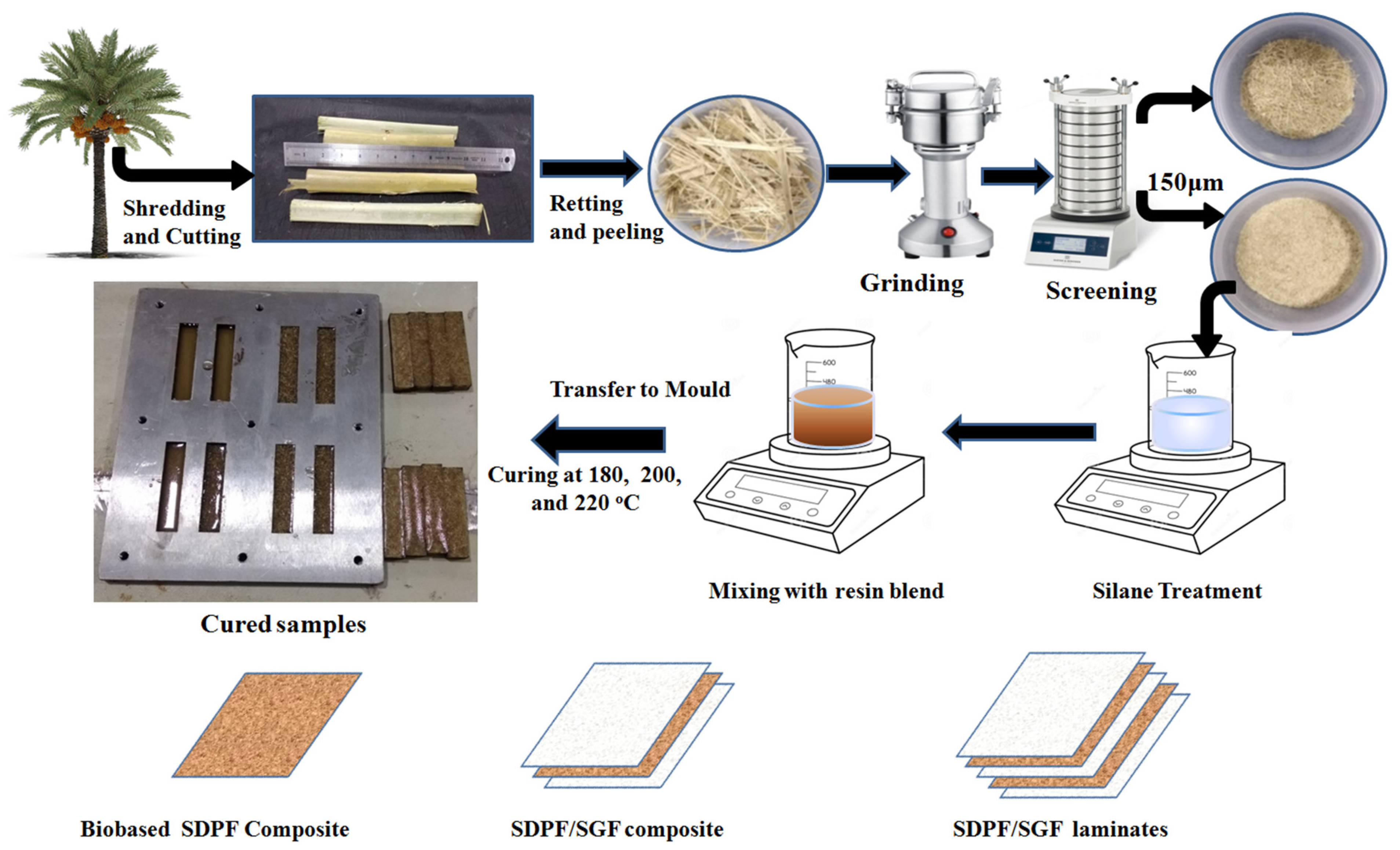
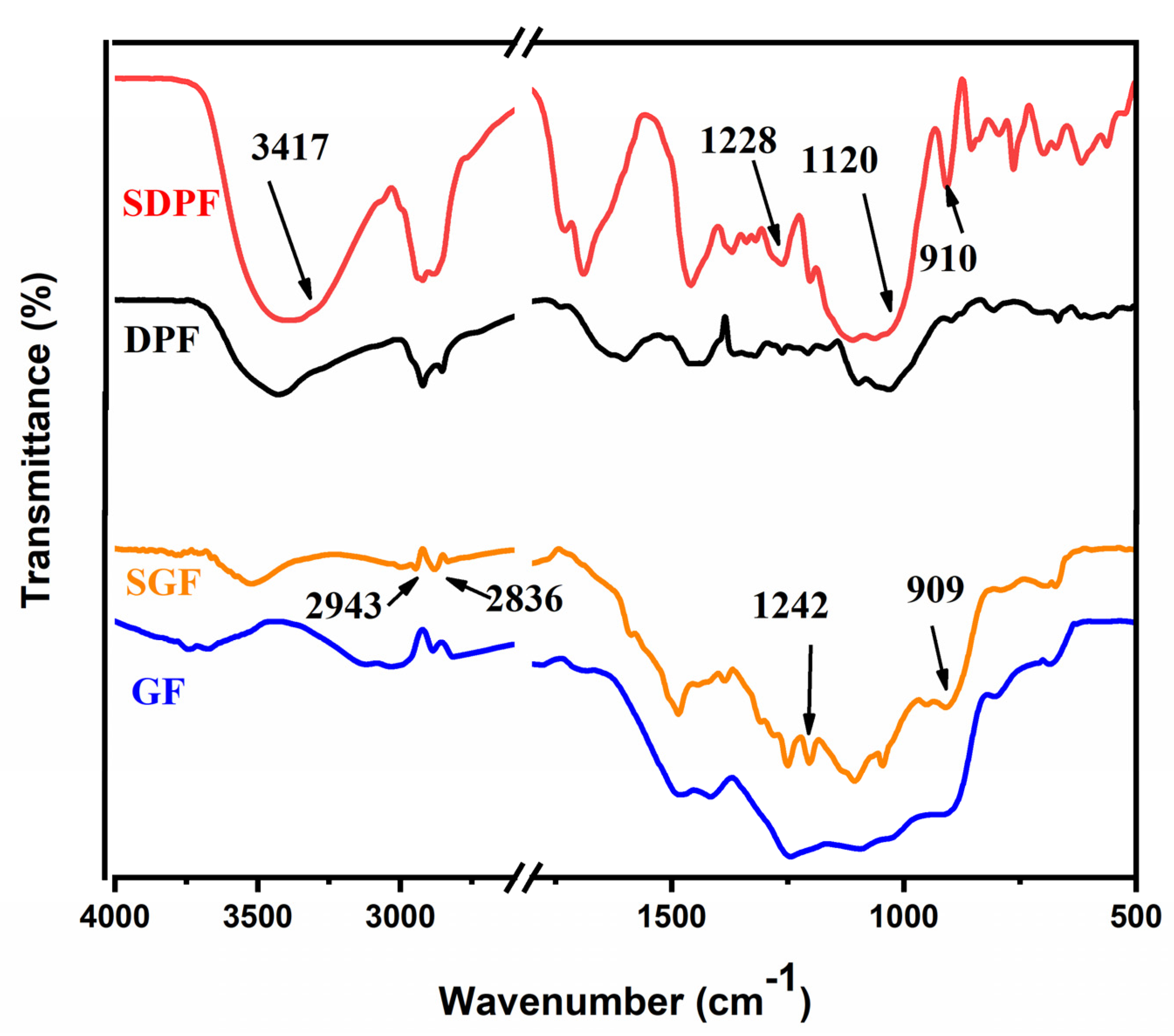

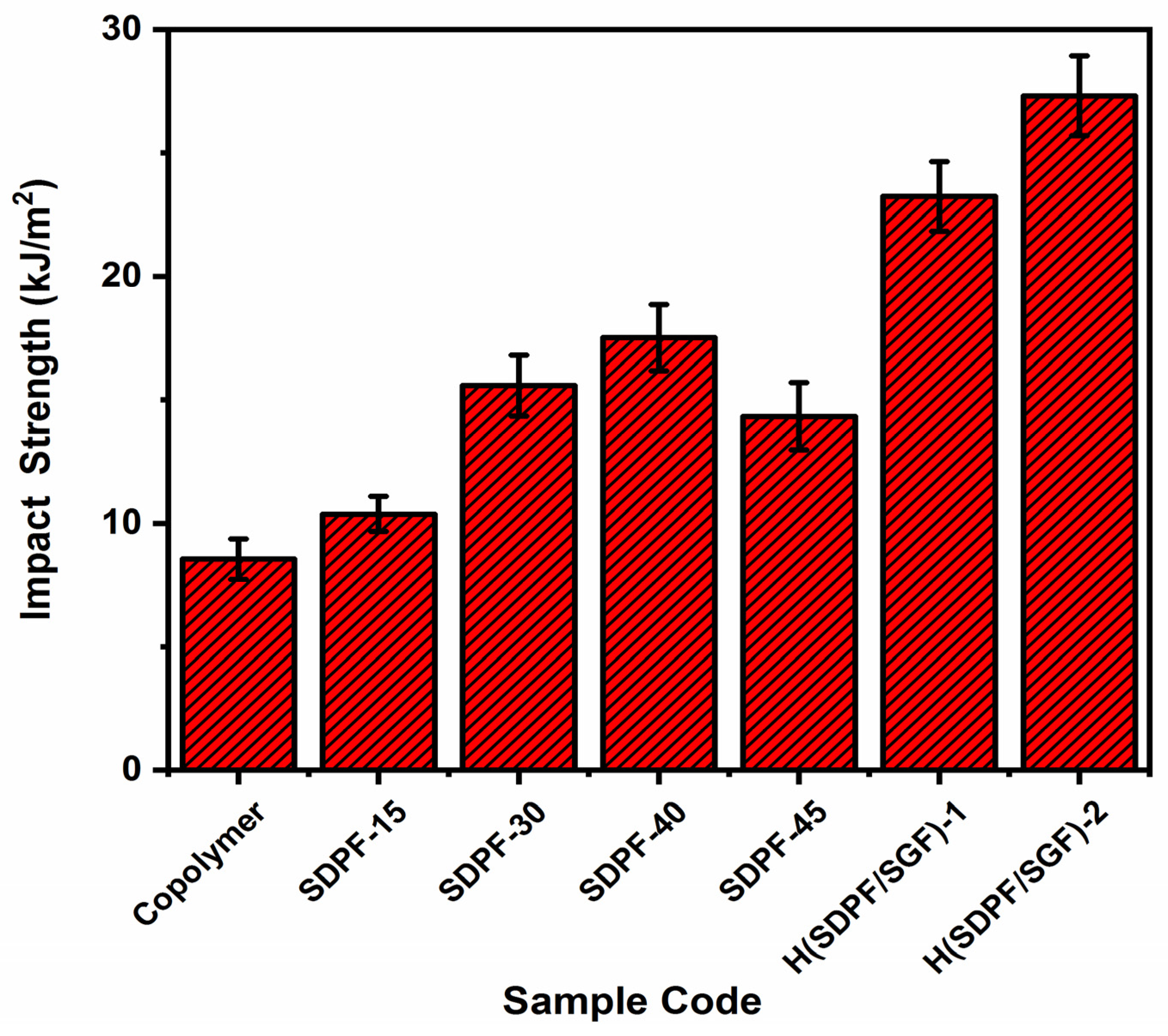
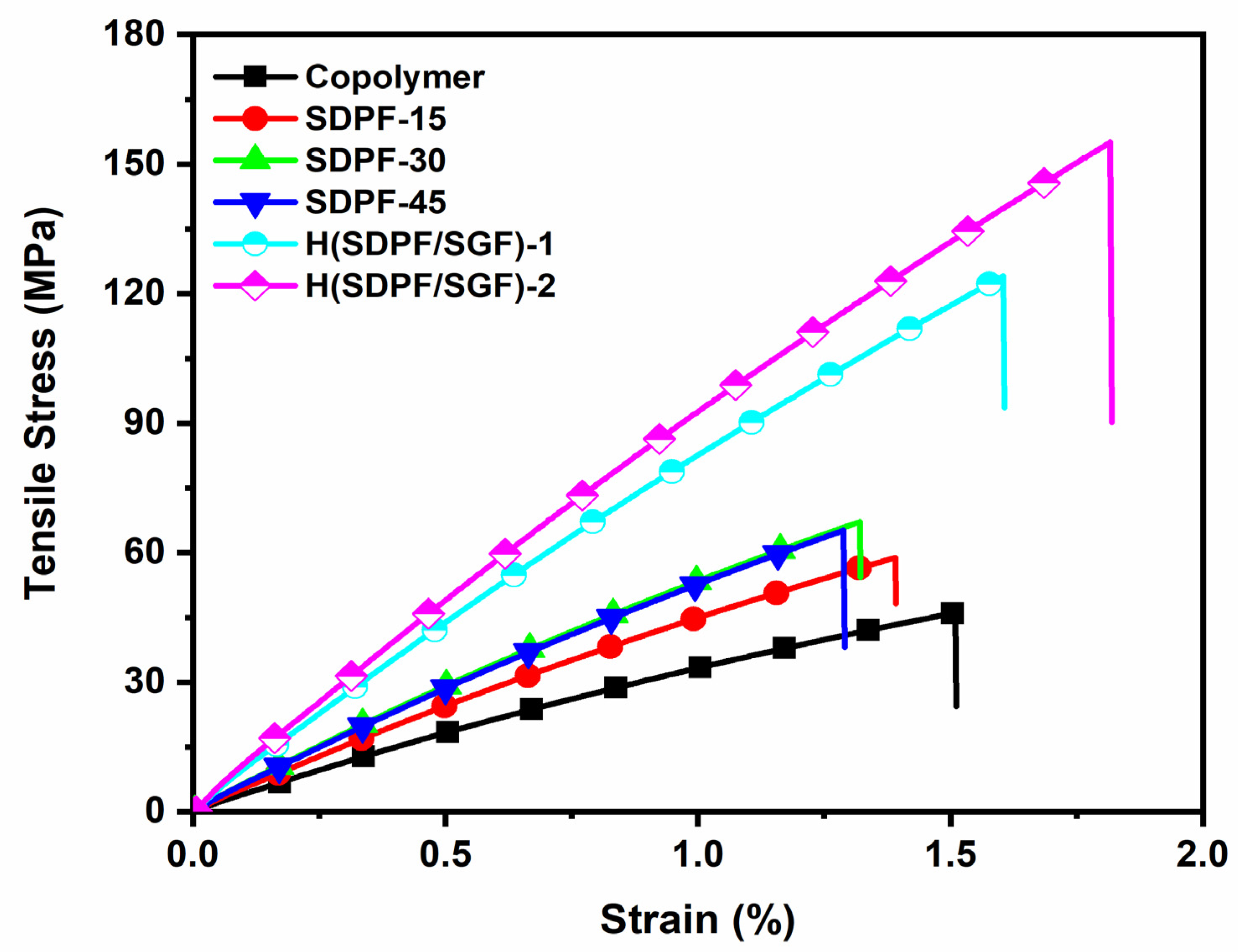
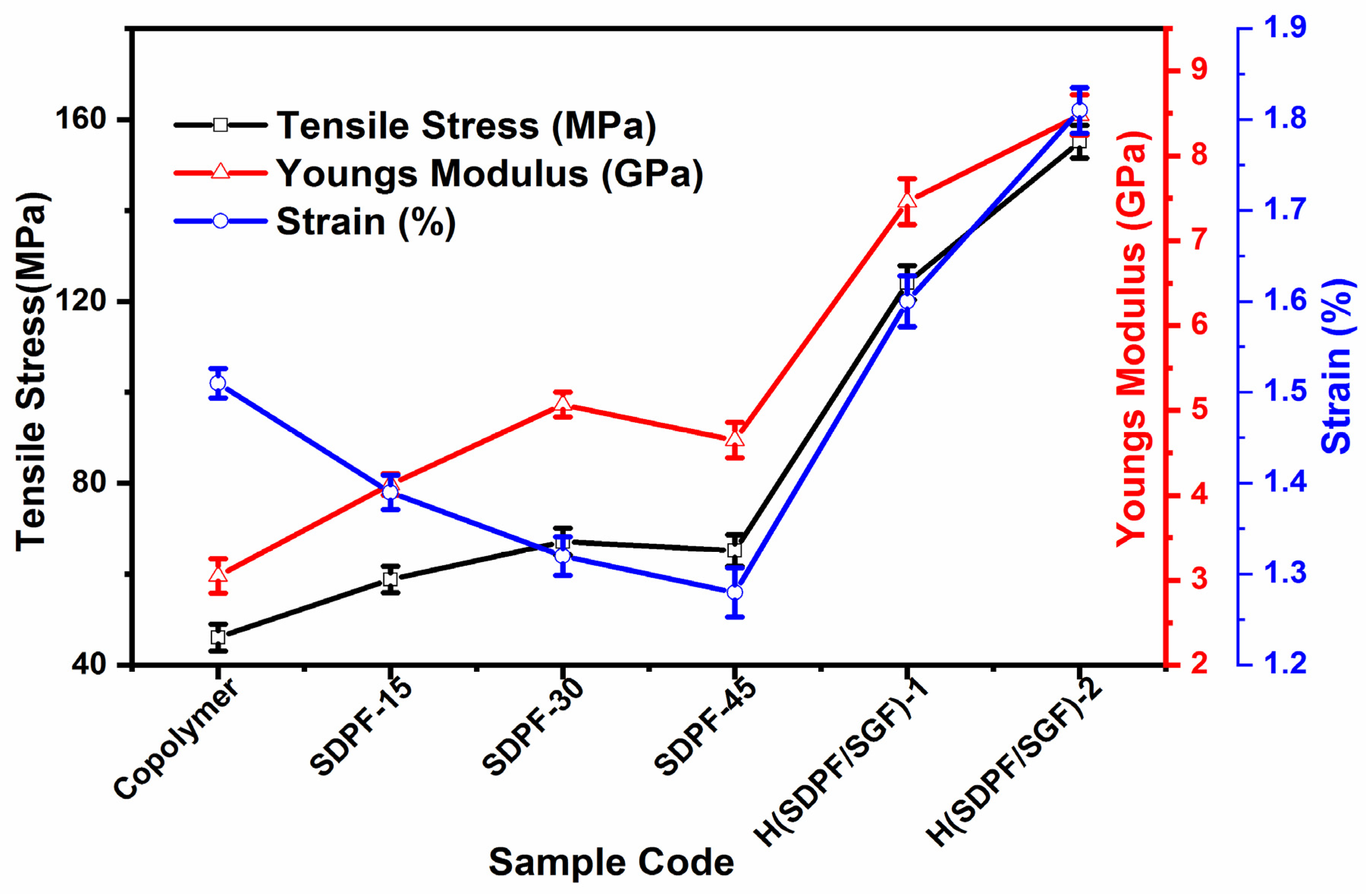

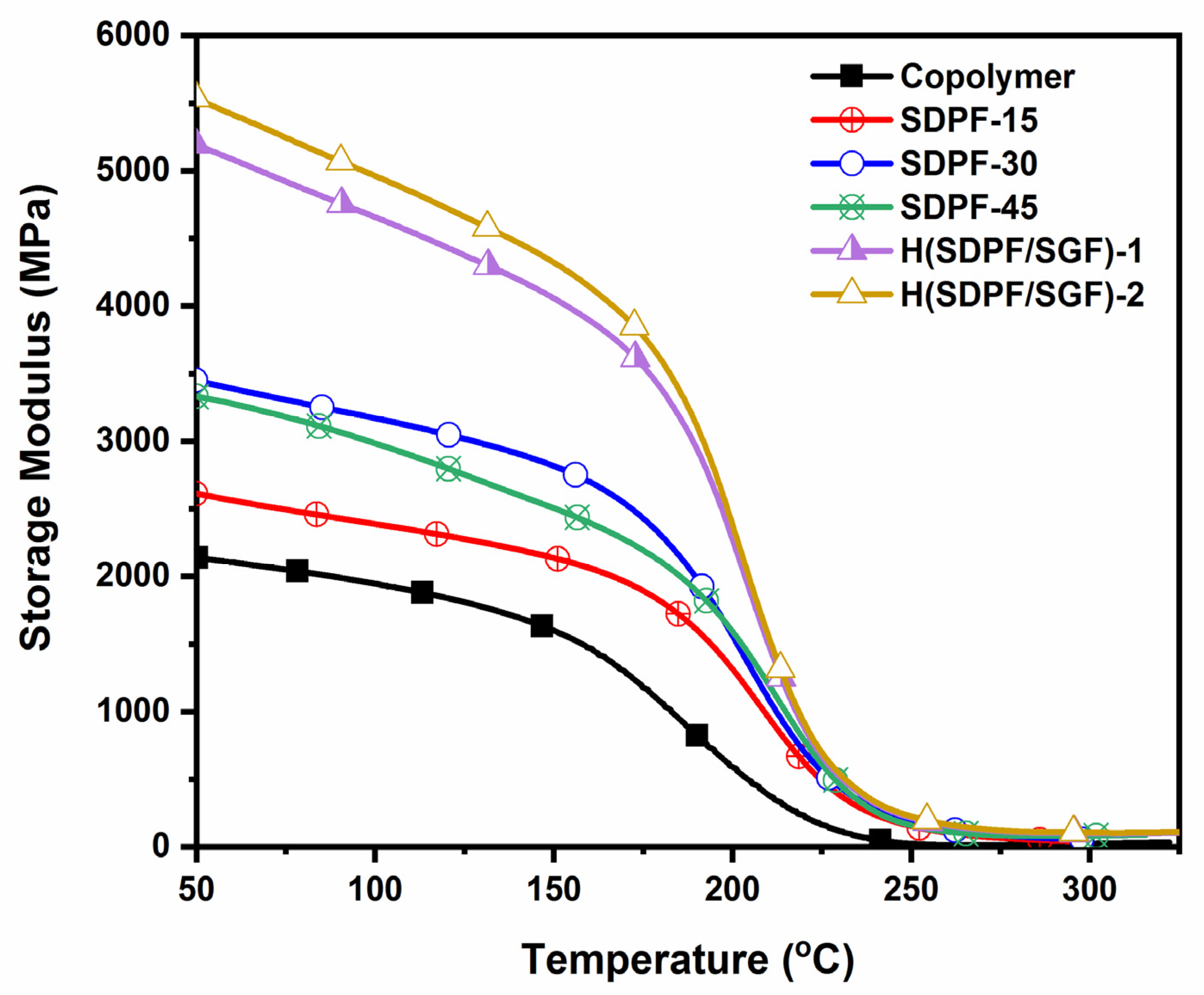

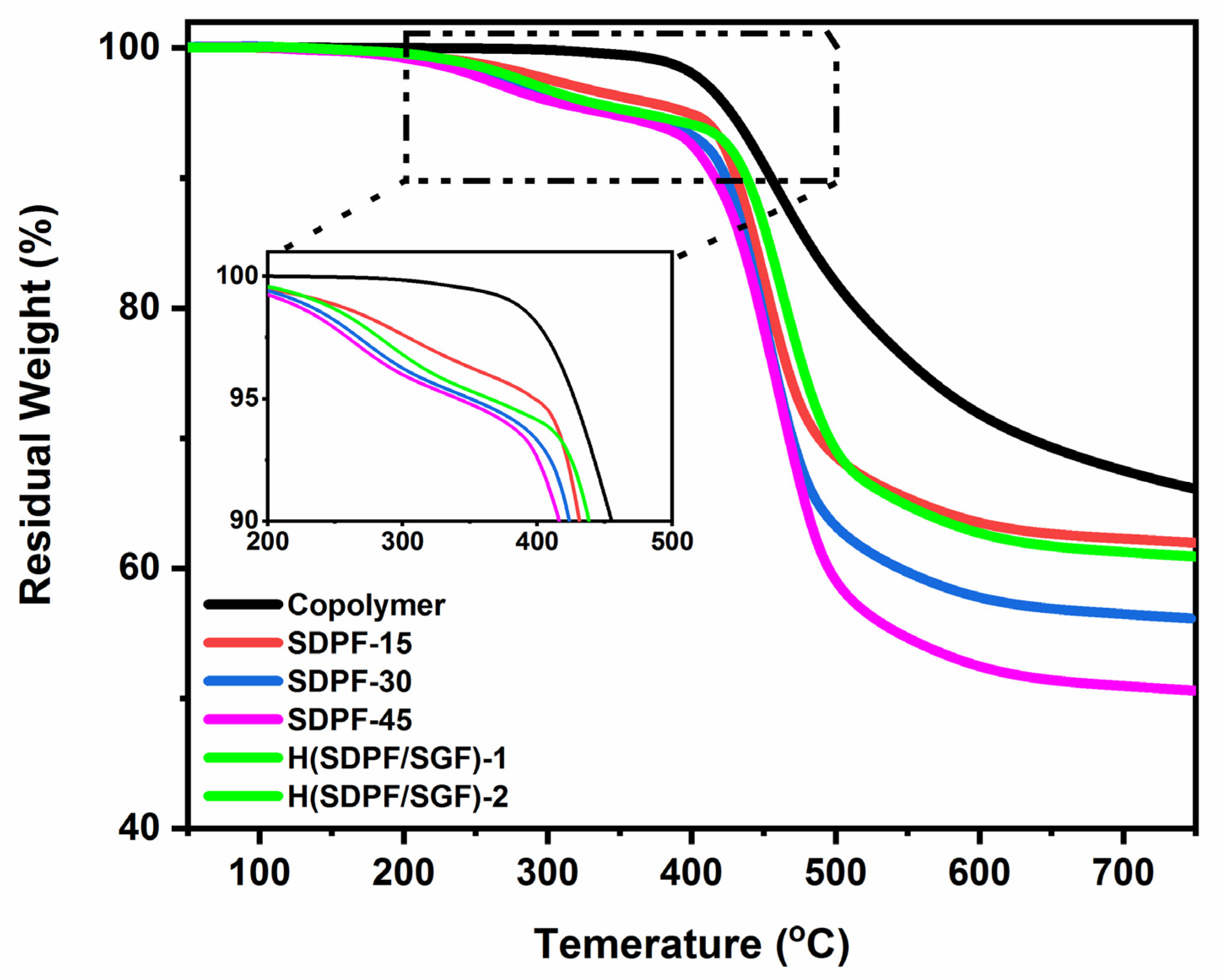

| Specimen Code | BA-a [wt.%] | EPN [wt.%] | SDPF [wt.%] | SGF | Vf | Stacking Sequence |
|---|---|---|---|---|---|---|
| Copolymer | 60 | 40 | - | - | 0 | Uniform |
| SDPF-15 | 51 | 34 | 15 | - | 0.185 | Uniform |
| SDPF-30 | 42 | 28 | 30 | - | 0.355 | Uniform |
| SDPF-45 | 33 | 22 | 45 | - | 0.512 | Uniform |
| H(SDPF/SGF)-1 | 33 | 22 | 30 | 2 Layer (7.5 wt.% each layer) | 0.458 | □×□ |
| H(SDPF/SGF)-2 | 33 | 22 | 30 (15 wt.% each layer) | 3 Layer (5 wt.% each layer) | 0.458 | □×□×□ |
| Sample | T5 [°C] | T10 [°C] | Yc at 750 °C [%] |
|---|---|---|---|
| Untreated DPF | 236 | 282 | 19.88 |
| SDPF | 261 | 315 | 22.47 |
| Untreated GF | 337 | - | 92.91 |
| SGF | 285 | 421 | 88.92 |
| Sample Code | Flexural Properties | Reference | ||
|---|---|---|---|---|
| Strength [MPa] | Modulus [GPa] | Strain [%] | ||
| Copolymer | 53.42 ± 3.69 | 2.03 ± 0.32 | 2.65 ± 0.07 | Current Work |
| SDPF-15 | 73.03 ± 5.32 | 3.12 ± 0.25 | 2.48 ± 0.09 | |
| SDPF-30 | 107.82 ± 4.37 | 4.58 ± 0.25 | 2.39 ± 0.05 | |
| SDPF-45 | 89.81 ± 6.16 | 4.79 ± 0.54 | 2.08 ± 0.06 | |
| H(SDPF/SGF)-1 | 168.71 ± 4.36 | 8.17 ± 0.35 | 2.51 ± 0.03 | |
| H(SDPF/SGF)-2 | 203.55 ± 4.71 | 9.62 ± 0.32 | 2.69 ± 0.04 | |
| Chopped GF-40 wt.% a | 148.64 ± 4.36 | 7.74 ± 0.216 | 1.38 ± 0.04 | [42] |
| Kevlar fiber-20 wt. % b | 149.78 ± 7.4 | 6.89 ± 5.3 | - | [43] |
| Flax/basalt fiber c | 144.8 | 8.27 | - | [44] |
| DPF/kenaf fiber d | 56.24 | 4.77 | - | [45] |
| Jute/basalt fiber d | 178.6 ± 2.9 | 10.60 ± 0.33 | - | [16] |
| Flax/GF d | 390.19 | 13.56 | - | [17] |
| Carbon cloth e | 756 | 119 | 0.9 | [23] |
| Sample | E’ @ 50 °C, [MPa] | tan delta [°C] | Effectiveness Coefficient C | ||
|---|---|---|---|---|---|
| 175 °C | 200 °C | 225 °C | |||
| Copolymer | 2139 | 225.5 | - | - | - |
| SDPF-15 | 2611 | 229.8 | 0.76 | 0.55 | 0.41 |
| SDPF-30 | 3448 | 235.1 | 0.68 | 0.50 | 0.39 |
| SDPF-45 | 3331 | 231.1 | 0.72 | 0.52 | 0.42 |
| H(SDPF/SGF)-1 | 5190 | 233.7 | 0.71 | 0.51 | 0.43 |
| H(SDPF/SGF)-2 | 5533 | 232.8 | 0.70 | 0.51 | 0.43 |
| Sample | T5 [°C] | T10 [°C] | Yc [%] | HRI [°C] | LOI [%] |
|---|---|---|---|---|---|
| Copolymer | 427.6 | 455.2 | 66.10 | 270.21 | 43.94 |
| SDPF-15 | 398.0 | 431.5 | 61.96 | 221.48 | 42.28 |
| SDPF-30 | 360.5 | 423.8 | 56.14 | 208.84 | 39.95 |
| SDPF-45 | 341.6 | 416.5 | 50.60 | 204.25 | 37.74 |
| H(SDPF/SGF)-1 | 364.8 | 438.3 | 60.89 | 230.26 | 41.85 |
| H(SDPF/SGF)-2 | 365.3 | 439.9 | 60.85 | 230.35 | 41.84 |
Publisher’s Note: MDPI stays neutral with regard to jurisdictional claims in published maps and institutional affiliations. |
© 2022 by the authors. Licensee MDPI, Basel, Switzerland. This article is an open access article distributed under the terms and conditions of the Creative Commons Attribution (CC BY) license (https://creativecommons.org/licenses/by/4.0/).
Share and Cite
Alshahrani, H.; Alshammari, B.A.; Shah, A.H.; Dayo, A.Q. Development of Hybrid Composite Utilizing Micro-Cellulose Fibers Extracted from Date Palm Rachis in the Najran Region. Polymers 2022, 14, 4687. https://doi.org/10.3390/polym14214687
Alshahrani H, Alshammari BA, Shah AH, Dayo AQ. Development of Hybrid Composite Utilizing Micro-Cellulose Fibers Extracted from Date Palm Rachis in the Najran Region. Polymers. 2022; 14(21):4687. https://doi.org/10.3390/polym14214687
Chicago/Turabian StyleAlshahrani, Hassan, Basheer A. Alshammari, Ahmer Hussain Shah, and Abdul Qadeer Dayo. 2022. "Development of Hybrid Composite Utilizing Micro-Cellulose Fibers Extracted from Date Palm Rachis in the Najran Region" Polymers 14, no. 21: 4687. https://doi.org/10.3390/polym14214687






